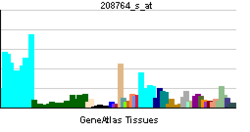ATP5G2
| View/Edit Human | View/Edit Mouse |
ATP synthase lipid-binding protein, mitochondrial is an enzyme that in humans is encoded by the ATP5G2 gene.[3][4]
This gene encodes a subunit of mitochondrial ATP synthase. Mitochondrial ATP synthase catalyzes ATP synthesis, utilizing an electrochemical gradient of protons across the inner membrane during oxidative phosphorylation. ATP synthase is composed of two linked multi-subunit complexes: the soluble catalytic core, F1, and the membrane-spanning component, F0, comprising the proton channel. The catalytic portion of mitochondrial ATP synthase consists of 5 different subunits (alpha, beta, gamma, delta, and epsilon) assembled with a stoichiometry of 3 alpha, 3 beta, and single representatives of the gamma, delta, and epsilon subunits. The proton channel likely has nine subunits (a, b, c, d, e, f, g, F6 and 8). There are three separate genes which encode subunit c of the proton channel and they specify precursors with different import sequences but identical mature proteins. The protein encoded by this gene is one of three precursors of subunit c. Alternatively spliced transcript variants encoding different isoforms have been identified. This gene has multiple pseudogenes.[4]
References
- ↑ "Human PubMed Reference:".
- ↑ "Mouse PubMed Reference:".
- ↑ Dyer MR, Walker JE (Aug 1993). "Sequences of members of the human gene family for the c subunit of mitochondrial ATP synthase". Biochem J. 293 (1): 51–64. doi:10.1042/bj2930051. PMC 1134319
 . PMID 8328972.
. PMID 8328972. - 1 2 "Entrez Gene: ATP5G2 ATP synthase, H+ transporting, mitochondrial F0 complex, subunit C2 (subunit 9)".
Further reading
- Farrell LB, Nagley P (1987). "Human liver cDNA clones encoding proteolipid subunit 9 of the mitochondrial ATPase complex.". Biochem. Biophys. Res. Commun. 144 (3): 1257–64. doi:10.1016/0006-291X(87)91446-X. PMID 2883974.
- Yan WL, Lerner TJ, Haines JL, Gusella JF (1995). "Sequence analysis and mapping of a novel human mitochondrial ATP synthase subunit 9 cDNA (ATP5G3).". Genomics. 24 (2): 375–7. doi:10.1006/geno.1994.1631. PMID 7698763.
- Houstĕk J, Andersson U, Tvrdík P, et al. (1995). "The expression of subunit c correlates with and thus may limit the biosynthesis of the mitochondrial F0F1-ATPase in brown adipose tissue.". J. Biol. Chem. 270 (13): 7689–94. doi:10.1074/jbc.270.13.7689. PMID 7706317.
- Higuti T, Kawamura Y, Kuroiwa K, et al. (1993). "Molecular cloning and sequence of two cDNAs for human subunit c of H(+)-ATP synthase in mitochondria.". Biochim. Biophys. Acta. 1173 (1): 87–90. doi:10.1016/0167-4781(93)90249-D. PMID 8485160.
- Elston T, Wang H, Oster G (1998). "Energy transduction in ATP synthase.". Nature. 391 (6666): 510–3. doi:10.1038/35185. PMID 9461222.
- Wang H, Oster G (1998). "Energy transduction in the F1 motor of ATP synthase.". Nature. 396 (6708): 279–82. doi:10.1038/24409. PMID 9834036.
- Harrington JJ, Sherf B, Rundlett S, et al. (2001). "Creation of genome-wide protein expression libraries using random activation of gene expression.". Nat. Biotechnol. 19 (5): 440–5. doi:10.1038/88107. PMID 11329013.
- Strausberg RL, Feingold EA, Grouse LH, et al. (2003). "Generation and initial analysis of more than 15,000 full-length human and mouse cDNA sequences.". Proc. Natl. Acad. Sci. U.S.A. 99 (26): 16899–903. doi:10.1073/pnas.242603899. PMC 139241
 . PMID 12477932.
. PMID 12477932. - Cross RL (2004). "Molecular motors: turning the ATP motor.". Nature. 427 (6973): 407–8. doi:10.1038/427407b. PMID 14749816.
- Gerhard DS, Wagner L, Feingold EA, et al. (2004). "The status, quality, and expansion of the NIH full-length cDNA project: the Mammalian Gene Collection (MGC).". Genome Res. 14 (10B): 2121–7. doi:10.1101/gr.2596504. PMC 528928
 . PMID 15489334.
. PMID 15489334. - Otsuki T, Ota T, Nishikawa T, et al. (2007). "Signal sequence and keyword trap in silico for selection of full-length human cDNAs encoding secretion or membrane proteins from oligo-capped cDNA libraries.". DNA Res. 12 (2): 117–26. doi:10.1093/dnares/12.2.117. PMID 16303743.

